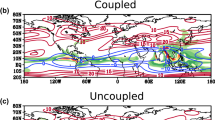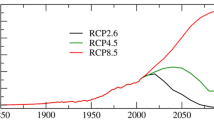Abstract
A coupling procedure of air-sea freshwater exchange in climate system models is reported in this note. The first stage of the procedure is to force OGCM to equilibrium under strong restoring surface condition on salinity, then increase the relaxing coefficient and get another steady state. The second stage is to switch the forcing on salinity from the weak restoring condition to the flux condition, and then finish a long-term spinning-up integration. After finishing these OGCM spinning-up stages, the last stage is to couple the OGCM with an active atmosphere, i.e. AGCM. Verification with the Global-Ocean-Atmosphere-Land-System model developed at the State Key Laboratory of Atmospheric Sciences and Geophysical Fluid Dynamics (LASG) shows that the preferred procedure is successful in including the air-sea freshwater exchange process.
Similar content being viewed by others
References
Zhou Tianjun, Zhang Xuehong, Wang Shaowu, The air-sea freshwater exchange derived from NCEP/NCAR reanalyses data, Acta Meteorologica Sinica (in Chinese), 1999, 57: 264.
Schmitt, R.W., The ocean component of the global water cycle, Reviews of Geophysics, 1995, Supplement (U.S. National Report to International Union of Geodesy and Geophysica 1991–1994): 1395.
Wu Guoxiong, Zhang Xuehong, Liu Hui et al., Global Ocean-Atmosphere-Land system model of LASG (GOALS/LASG) and its performance in simulation study, Quarterly Journal of Applied Meteorology (in Chinese), 1997, 8 (supplement): 15.
Haney, L., R., Surface boundary condition for ocean circulation models, J. Phys. Oceanogr., 1971, 1: 241.
Huang Ruixin, Real freshwater flux as a natural boundary condition for the salinity balance and thermohaline circulation forced by evaporation and precipitation, J. Phys. Oceanogr., 1993, 23: 2428.
Bryan, K. Manabe, S., Pacanowski, R. C., A global ocean-atmospheric climate model, Part II, The ocean circulation, J. Phys. Oceanogr., 1975, 5: 30.
Bryan, F., High latitude salinity effects and interhemispheric thermohaline circulation, Nature, 1986, 323: 25301.
Weaver, A. J., Sarachik, E. S., The role of mixed boundary condition in numerical models of the ocean’s climate, J. Phys. Oceanogr., 1991, 21: 1470.
Jin Xiangze, Zhang Xuehong, Zhou Tianjun., Fundamental framework and experiments of the Third Generation of IAP/LASG World Ocean General Circulation Model, Advance in Atmospheric Sciences, 1999, 16: 197.
Yu Yongqiang, Zhang Xuehong, A modified scheme for air-sea coupling, Chinese Science Bulletin (in Chinese), 1998, 43: 866.
Tziperman, E., Toggweiler, J. R., Feliks, F. et al., Instability of the thermohaline circulation with respect to mixed boundary conditions: Is it really a problem for realistic models? J. Phys. Oceanogr, 1994, 24: 217.
Author information
Authors and Affiliations
Corresponding author
About this article
Cite this article
Zhou, T., Zhang, X. & Yu, Y. The coupling procedure of air-sea freshwater exchange in climate system models. Chin.Sci.Bull. 46, 83–85 (2001). https://doi.org/10.1007/BF03183217
Received:
Issue Date:
DOI: https://doi.org/10.1007/BF03183217




